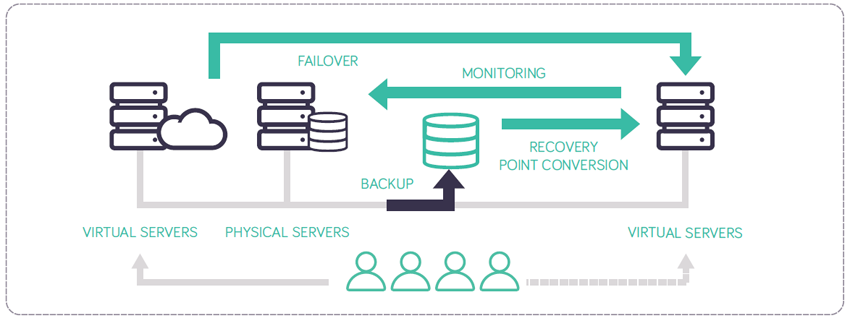
Arcserve High Availability Software
VMware System, Application and Data Availability

Overview:
Arcserve High Availability is software that provides continuous system, application and data protection and availability for Windows, Linux and UNIX on both virtual and physical servers without the need for a clustering architecture. Arcserve High Availability automatically synchronizes your Production VM(s) with Replica VM(s), typically on a separate host, which will be used for failover after a host, VM or application outage. The Replica VM can reside on a local host on the LAN or a remote host across the WAN. Arcserve High Availability can be used to even failover directly to Amazon Web Services Elastic Cloud Compute (AWS/EC2) public cloud using Full System Protection feature that replicates an entire Windowsbased VM system (operating system, system state, application and data) to an offline VM (virtual appliance).
After the initial synchronization, it performs real-time, continuous byte-level asynchronous replication between Production VMs and Replica VMs to keep systems, applications and data at the same level. Arcserve High Availability performs real-time server and application monitoring and offers both automatic and push-button failover for continuous application and data availability along with push-button failback. Arcserve High Availability includes application-aware replication and failover for Microsoft Exchange, SQL Server, SharePoint, Internet Information Services (IIS) and Microsoft Dynamics CRM as well as Oracle and BlackBerry Enterprise Server, providing auto-discovery for fast deployment and transactional integrity during replication and failover. You can protect other Windows applications by using the Custom Application Protection wizard or by creating a simple script. In addition, you can protect Linux and UNIX applications by creating a simple script. It should be noted that replication actually occurs during the initial synchronization and is spooled on the Replica server and applied once synchronization is completed.
If you use Full System Protection, it provides hardware-independent Bare Metal Recovery to rebuild the production VM and then resynchronize with the failover VM to recover the production environment—all while end-users continue to use the failover VM. This approach protects your VM system, application and data—all with a single solution.
How does Arcserve High Availability add value to VMware?
Most organizations like to have options. Arcserve High Availability gives organizations the flexibility to protect both their physical and virtual server environments, no matter which virtualization platform they use, with a single, integrated solution from one vendor. Arcserve High Availability protects the applications and data running in each virtual machine on the VMware ESX or VMware vSphere server. It also protects VMware vCenter Server through replication and automated failover for high availability. In addition, Arcserve High Availability is a hardware-independent solution, so organizations can use any server and storage device at both production and DR sites, which may help to reduce the total cost of ownership (TCO).
Other Uses
Besides providing high availability for VMware environments, you can use Arcserve High Availability to help migrate data from older x86-based servers to newer x64-based servers, or from physical servers to virtual servers. Of course, you can use any virtualized server for the Replica servers to help reduce DR costs. With its push-button failover feature, you can also use Arcserve High Availability to manually failover to the Replica server to enable IT staff to perform hardware and/or software maintenance on the Production servers without disrupting the production environment.
 Safeguard your Orofitability (and Sanity) with High Availability Software
Safeguard your Orofitability (and Sanity) with High Availability Software
When business systems and applications go down, the calls for blood begin—and downtime doesn’t respect office hours. Reduce the impact of unplanned outages.
Arcserve High Availability helps you:
- Deliver on business continuity and disaster recovery strategies
- Reduce system downtime
- Prevent against data loss
- Meet demanding—and varied— service level agreements
- Mitigate risk of lost sales, service, and brand loyalty
- Boost employee productivity
In short, a robust high availability architecture ensures uptime—and your peace of mind.
 Optimize RPOs and RTOs with enterprise-class features
Optimize RPOs and RTOs with enterprise-class features
Arcserve High Availability software offers easy-to-use features that share a common purpose—to keep you up and running.
We’re talking high availability features, like:
- Push-button and automated failover and failback
- Fully-automated business continuity and disaster recovery plan testing
- Real-time LAN and WAN data replication for protection onsite, offsite, and in the cloud
- Data rewind for continuous data protection
- System migration
What’s more, Arcserve High Availability software is widely compatible, ensuring continuous availability for:
- Physical and virtual servers
- Windows, Linux, and UNIX server operating systems
Differentiators:
Arcserve High Availability offers key differentiators when you compare it to high-availability solutions from VMware.
- VMware Fault Tolerance requires clustering architecture and VMware vCenter Site Recovery Manager (SRM) requires a shared storage infrastructure for the DR site and the production environment. The production environment also requires shared, centralized storage, which is often connected to the SAN or iSCSI storage. All of these can be costly solutions.
- Arcserve High Availability, enables implementation of a comprehensive data protection solution by using costeffective hardware and storage for the Replica servers.
- Arcserve High Availability, enables implementation of a comprehensive data protection solution by using costeffective hardware and storage for the Replica servers.
- In this way, IT can avoid the need for expensive hardware clustering or shared storage infrastructure as a prerequisite. But of course, Arcserve High Availability can protect data on network attached storage (NAS) and SAN, too.
- With VMware vCenter Server SRM, monitoring of the virtual machines is performed at the ESX/Virtual Center level and only detects problems with the Virtual Machine operating system. When running a critical application such as Microsoft Exchange, SQL Server, SharePoint, Microsoft Dynamics CRM, IIS, Oracle or BlackBerry, if the application fails, VMware SRM or Clustering would not detect a specific application or application service failure and therefore would not automatically fail over. To address this challenge, VMware now also offers VMware App HA.
- Arcserve High Availability provides in-depth monitoring of the applications running on the VMs. It alerts IT to an application failure and you can set it to automatically fail over to the Replica server, or use push-button failover instead.
- Arcserve High Availability provides in-depth monitoring of the applications running on the VMs. It alerts IT to an application failure and you can set it to automatically fail over to the Replica server, or use push-button failover instead.
- With VMware SRM, when provisioning a VM from one machine to another, the image is cloned, so the new VM will have the same machine name and IP address as the failed VM. This works for failover, but introduces challenges when IT attempts to repair the problem that affected the Production VM. It makes it very difficult for IT to remotely access the Production VM to understand why it failed, troubleshoot the system, and restart the failed application.
- In Arcserve High Availability, failover occurs by redirecting the server traffic and users at the DNS server level. This means that no changes are made to any server configuration of the Production or Replica VMs during or after a failover. This also makes managing VMs off-site much easier because it is not necessary to create a virtual LAN to enable an IP address from your production subnet to work on the DR site (which is most likely on a different IP subnet).
- Data loss and corruption in a virtualized environment adds another level of challenge, typically because of the shared storage architecture that is used. If an application corrupts data, or a virus or malicious code makes changes to the data, no amount of provisioning between VMs will address the problem.
- Arcserve High Availability includes a Data Rewind feature to provide continuous data protection (CDP) that enables fast and easy rewind back to a known, good point in time before data loss or damage, such as a database checkpoint. Data Rewind complements any periodic backup solution and helps IT organizations to meet demanding recovery time objectives (RTOs) and recovery point objectives (RPOs), reducing data loss.
- Arcserve High Availability includes a Data Rewind feature to provide continuous data protection (CDP) that enables fast and easy rewind back to a known, good point in time before data loss or damage, such as a database checkpoint. Data Rewind complements any periodic backup solution and helps IT organizations to meet demanding recovery time objectives (RTOs) and recovery point objectives (RPOs), reducing data loss.
- Even the most virtualization-savvy businesses and organizations maintain physical server environments. While VMware solutions can be used on VMware servers, most organizations need to protect their physical servers too, and many are also using or investigating other virtualization solutions such as Microsoft Hyper-V and Citrix XenServer.
- As we mentioned above, Arcserve High Availability protects both physical and virtual servers—including VMware, Microsoft Hyper-V and Citrix XenServer.
- As we mentioned above, Arcserve High Availability protects both physical and virtual servers—including VMware, Microsoft Hyper-V and Citrix XenServer.
- VMware offers only snapshot-based DR testing for its own high-availability solution.
- Arcserve High Availability includes Arcserve Assured Recovery for automated, non-disruptive testing that covers both physical and all virtual environments. It may be scheduled for daily, weekly or even hourly lights-out recovery testing of the application data running on your Replica server or VM for disaster recovery. This process also offers integrated VSS Snapshot management, so you can perform application-consistent tape-based or diskbased backups off the Replica server, avoiding impact to the production environment.
Other differentiators include:
- Built-in 128-bit Secure Sockets Layer (SSL) encryption over the network without requiring a virtual private network (VPN) or IPSec tunnel.
- Replication options (continuous and scheduled) to balance network resources with the required level of protection.
- Offline synchronization to speed deployment and protection for large Windows-based data sets and databases.
- Group failover used when protecting groups of servers or server farms for applications such as SharePoint, Microsoft Dynamics CRM and websites. You can failover a group of servers together, even if only one server experiences trouble, to keep all component servers physically located together for application performance reasons.
- Multi-stream replication, which helps to speed the replication process over high-latency WANs.
- Amazon cloud (AWS/EC2) integration for Windows-based application and file server replication and failover using Amazon remote facilities and resources. Using the cloud can help you convert capital expenditure (CAPEX) to operational expenditure (OPEX) and reduce operation and maintenance requirements, while enabling better budget planning.
Deployments:
Arcserve High Availability Deployment

Documentation:
Download the Arcserve High Availability Solution Brief Data Sheet (PDF)
